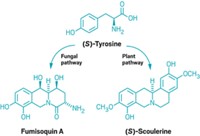Advertisement
Grab your lab coat. Let's get started
Welcome!
Welcome!
Create an account below to get 6 C&EN articles per month, receive newsletters and more - all free.
It seems this is your first time logging in online. Please enter the following information to continue.
As an ACS member you automatically get access to this site. All we need is few more details to create your reading experience.
Not you? Sign in with a different account.
Not you? Sign in with a different account.
ERROR 1
ERROR 1
ERROR 2
ERROR 2
ERROR 2
ERROR 2
ERROR 2
Password and Confirm password must match.
If you have an ACS member number, please enter it here so we can link this account to your membership. (optional)
ERROR 2
ACS values your privacy. By submitting your information, you are gaining access to C&EN and subscribing to our weekly newsletter. We use the information you provide to make your reading experience better, and we will never sell your data to third party members.
Synthesis
Missing pieces of natural product synthesis found
Unusual polyketide synthase involved in making tropane alkaloids
by Celia Henry Arnaud
December 17, 2018

Tropane alkaloids, a broad class of natural products from plants, have been used as medicines for more than a century. Tropinone, the simplest tropane alkaloid, is a key intermediate in the synthesis of many others. It was first chemically synthesized in 1901, but the enzymes plants use to make it have remained a mystery—one that has now been solved.
Cornelius S. Barry, A. Daniel Jones, and Matthew A. Bedewitz of Michigan State University and John C. D’Auria of Texas Tech University have now identified two genes in Atropa belladonna (deadly nightshade) that code for enzymes that make tropinone (Nat. Commun. 2018, DOI: 10.1038/41467-018-07671-3).
The first enzyme is a type III polyketide synthase called AbPYKS. Unusually, AbPYKS uses an N-methyl-∆1-pyrrolinium cation as its starter substrate. All other known polyketide synthases have coenzyme A attached to their starter substrates to jumpstart the reaction. “We believe the pyrrolinium cation is so reactive that it alleviates the need for having the CoA thioester,” Barry says. The enzyme adds malonyl-CoA twice to make a diketide, 4-(1-methyl-2-pyrrolidinyl)-3-oxobutanoic acid. The researchers don’t yet know the mechanism by which the reaction occurs.
Ikuro Abe, a natural products chemist at the University of Tokyo, calls it a “significant and remarkable achievement” that this “long-sought enzyme was finally discovered.”
In theory, a polyketide synthase might be able to make tropinone directly, Barry says. But the deadly nightshade uses a second enzyme. The researchers found that a cytochrome P450 called AbCYP82M3 catalyzes the cyclization reaction needed to complete the 8-azabicyclo[3.2.1]octane core found in all tropane alkaloids. The formation of this core is a key step in synthesizing tropinone, says F. Peter Guengerich, an expert on P450s at Vanderbilt University. “This appears to be another nice example of the flexibility of P450s in catalyzing seemingly unusual C–C bond coupling reactions,” he says.
To demonstrate that these enzymes really were responsible for making tropinone, the researchers engineered them into tobacco, which doesn’t usually make tropanes. Indeed, plants carrying the key enzymes were able to produce tropinone.
Identifying this pair of enzymes could eventually enable researchers to engineer microbes to make tropinone or other compounds such as atropine or scopolamine. But as Barry points out, “before we can engineer tropanes we still need to identify the missing pieces in the puzzle, particularly the enzymes required for the formation of littorine, a key intermediate on the path to atropine and scopolamine.” Barry’s group is now working to identify those missing enzymes.





Join the conversation
Contact the reporter
Submit a Letter to the Editor for publication
Engage with us on Twitter